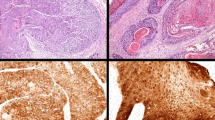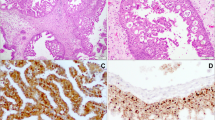Abstract
Background
Sinonasal adenosquamous carcinoma is rare, and there are almost no studies detailing morphology or characterizing their genetic driver events. Further, many authors have termed sinonasal tumors with combined squamous carcinoma and glands as mucoepidermoid carcinoma but none have analyzed for the presence of MAML2 rearrangement.
Methods
Cases from 2014 to 2020 were collected and diagnosed using World Health Organization criteria. They were tested for p16 expression by immunohistochemistry (70% cut-off), DEK::AFF2 fusion by fluorescence in situ hybridization (FISH) and AFF2 immunohistochemistry, MAML2 rearrangement by FISH, and low- and high-risk HPV by RNA ISH and reverse transcription PCR, respectively. Detailed morphology and clinical features were reviewed.
Results
There were 7 male (64%) and 4 female (36%) patients with a median age of 69 years, most Caucasian (10 of 11 or 91%). Most had tobacco exposure (8/11, 73%) and most presented with epistaxis, a visible nasal mass, and/or facial pain. Several had a precursor papillomas (3 of 11, 27%). The squamous component had variable keratinization, 5 of 11 (46%) of which would be described as keratinizing, 3 non-keratinizing, and 2 with mixed features. All had gland formation, by definition, and 2 of 11 (18%) had ciliated tumor cells. None of the 11 cases had MAML2 rearrangement and one had DEK::AFF2 fusion with associated positive nuclear AFF2 protein immunostaining. Most were p16 positive (7 of 11, 64%) and all 7 of these were hrHPV positive either by RNA ISH or RT-PCR. Two of the p16-negative tumors were positive for lrHPV by RNA ISH. Treatment included surgery alone (4 of 11, 36%), surgery with adjuvant radiation (5 of 11, 45%), and surgery with radiation and chemotherapy (2 of 11, 18%). Four of 11 patients (36%) suffered disease recurrence, two requiring re-operation and who were disease free at last follow-up, one receiving additional chemotherapy and who was alive with disease. The other elected to undergo palliative therapy and died of disease.
Conclusion
Sinonasal adenosquamous carcinoma is a somewhat heterogeneous tumor not infrequently arising ex papilloma and having various drivers including high- and low-risk HPV and rarely DEK::AFF2 fusion. The prognosis appears favorable when proper treatment is possible.





Similar content being viewed by others
Data Availability
Not applicable.
Code Availability
Not applicable.
References
Schick U, Pusztaszeri M, Betz M, Ghadjar P, Demiroz C, Kaanders JH et al (2013) Adenosquamous carcinoma of the head and neck: report of 20 cases and review of the literature. Oral Surg Oral Med Oral Pathol Oral Radiol 116(3):313–320
Kass JI, Lee SC, Abberbock S, Seethala RR, Duvvuri U (2015) Adenosquamous carcinoma of the head and neck: molecular analysis using CRTC-MAML FISH and survival comparison with paired conventional squamous cell carcinoma. Laryngoscope 125(11):E371–E376
Masand RP, El-Mofty SK, Ma XJ, Luo Y, Flanagan JJ, Lewis JS Jr (2011) Adenosquamous carcinoma of the head and neck: relationship to human papillomavirus and review of the literature. Head Neck Pathol 5(2):108–116
Vazquez A, Khan MN, Blake DM, Patel TD, Baredes S, Eloy JA (2015) Sinonasal squamous cell carcinoma and the prognostic implications of its histologic variants: a population-based study. Int Forum Allergy Rhinol 5(1):85–91
Lee RJ, Lin T, Lee SA, Lee KK, Christensen RE (2017) Importance of tumor extent in adenosquamous carcinoma of the head and neck: a retrospective cohort study. Oral Surg Oral Med Oral Pathol Oral Radiol 124(2):114–120
Nudell J, Chiosea S, Thompson LD (2014) Carcinoma Ex-Schneiderian Papilloma (Malignant Transformation): a clinicopathologic and immunophenotypic study of 20 cases combined with a comprehensive review of the literature. Head Neck Pathol 8(3):269–286
Wolfish EB, Nelson BL, Thompson LD (2012) Sinonasal tract mucoepidermoid carcinoma: a clinicopathologic and immunophenotypic study of 19 cases combined with a comprehensive review of the literature. Head Neck Pathol 6(2):191–207
Alos L, Castillo M, Nadal A, Caballero M, Mallofre C, Palacin A et al (2004) Adenosquamous carcinoma of the head and neck: criteria for diagnosis in a study of 12 cases. Histopathology 44(6):570–579
Prasad ML, Wenig BM (2022) Adenosquamous carcinoma. WHO classification of Tumours Editorial Board - Head and Neck Tumours [Internet; beta version ahead of print], 5th edn. IARC Press, Lyon
Cardesa A, Zidar N, Alos L (2005) Adenosquamous carcinoma. In: Barnes L, Eveson J, Reichart P, Sidransky D (eds) Pathology and Genetics Head and Neck Tumours. IARC Press, Lyon, pp 130–131
Fonseca FP, Ramos LM, Vargas PA, de Almeida OP, Lopes MA, Santos-Silva AR (2012) Oral adenosquamous carcinoma: evidence that it arises from the surface mucosal epithelium. Histopathology 61(2):321–323
Chiosea SI, Dacic S, Nikiforova MN, Seethala RR (2012) Prospective testing of mucoepidermoid carcinoma for the MAML2 translocation: clinical implications. Laryngoscope 122(8):1690–1694
Seethala RR, Dacic S, Cieply K, Kelly LM, Nikiforova MN (2010) A reappraisal of the MECT1/MAML2 translocation in salivary mucoepidermoid carcinomas. Am J Surg Pathol 34(8):1106–1121
Fiacchini G, Benettini G, Trico D, Torregrossa L, Vianini M, Picariello M et al (2021) Human papillomavirus-related head and neck adenosquamous carcinoma: a systematic review and individual patient data meta-analysis. Oral Oncol 119:105252
Mehrad M, Trinkaus K, Lewis JS (2016) Jr. Adenosquamous Carcinoma of the Head and Neck: a case-control study with conventional squamous cell carcinoma. Head Neck Pathol 10(4):486–493
Chen MM, Roman SA, Sosa JA, Judson BL (2014) Histologic grade as prognostic indicator for mucoepidermoid carcinoma: a population-level analysis of 2400 patients. Head Neck 36(2):158–163
Bishop JA, Guo TW, Smith DF, Wang H, Ogawa T, Pai SI et al (2013) Human papillomavirus-related carcinomas of the sinonasal tract. Am J Surg Pathol 37(2):185–192
Bishop JA, Westra WH (2012) Human papillomavirus-related carcinomas of the sinonasal tract. Mod Pathol 25(Supplement 2):305A
Rooper LM, Agaimy A, Dickson BC, Dueber JC, Eberhart CG, Gagan J et al (2021) DEK-AFF2 Carcinoma of the Sinonasal Region and Skull Base: detailed clinicopathologic characterization of a distinctive entity. Am J Surg Pathol 45(12):1682–1693
Kuo YJ, Lewis JS Jr, Zhai C, Chen YA, Chernock RD, Hsieh MS et al (2021) DEK-AFF2 fusion-associated papillary squamous cell carcinoma of the sinonasal tract: clinicopathologic characterization of seven cases with deceptively bland morphology. Mod Pathol 34(10):1820–1830
Bishop JA, Gagan J, Paterson C, McLellan D, Sandison A (2021) Nonkeratinizing squamous cell carcinoma of the Sinonasal Tract with DEK-AFF2: further solidifying an emerging entity. Am J Surg Pathol 45(5):718–720
Kuo YJ, Lewis JS Jr, Truong T, Yeh YC, Chernock RD, Zhai C et al (2022) Nuclear expression of AFF2 C-terminus is a sensitive and specific ancillary marker for DEK::AFF2 carcinoma of the sinonasal tract. Mod Pathol 35(11):1587–1595
Lewis JS Jr, Beadle B, Bishop JA, Chernock RD, Colasacco C, Lacchetti C et al (2018) Human papillomavirus testing in Head and Neck Carcinomas: Guideline from the College of American Pathologists. Arch Pathol Lab Med 142(5):559–597
Gao G, Chernock RD, Gay HA, Thorstad WL, Zhang TR, Wang H et al (2012) A novel RT-PCR method for quantification of human papillomavirus transcripts in archived tissues and its application in oropharyngeal cancer prognosis. Int J Cancer. 132(4):882–890
Elgart K, Faden DL (2020) Sinonasal squamous cell carcinoma: etiology, pathogenesis, and the role of human papilloma virus. Curr Otorhinolaryngol Rep 8(2):111–119
Sharma A, Tang AL, Takiar V, Wise-Draper TM, Langevin SM (2021) Human papillomavirus and survival of sinonasal squamous cell Carcinoma Patients: a systematic review and Meta-analysis. Cancers (Basel) 13(15):3677
Nguyen ES, Risbud A, Birkenbeuel JL, Murphy LS, Goshtasbi K, Pang JC et al (2022) Prognostic factors and outcomes of De Novo Sinonasal squamous cell carcinoma: a systematic review and Meta-analysis. Otolaryngol Head Neck Surg 166(3):434–443
Acknowledgements
The authors would like to thank the staff of the Tissue Pathology Shared Resource (TPSR) for the excellent work on the immunostains used in this study.
Funding
Research was performed using discretionary funds from the Department of Pathology, Microbiology, and Immunology. The work also utilized the Translational Pathology Shared Resource (TPSR) at Vanderbilt University Medical Center which is supported by the NCI/NIH Cancer Center Support Grant 5P30 CA68485-19 and the Shared Instrumentation Grant S10 OD023475.
Author information
Authors and Affiliations
Contributions
All authors whose names appear on the submission made substantial contributions to the conception or design of the work, to the acquisition, analysis, or interpretation of data, and/or drafted the work or revised it critically for important intellectual content including approving the version to be published. They agree to be accountable for all aspects of the work in ensuring that questions related to the accuracy or integrity of any part of the work are appropriately investigated and resolved.
Corresponding author
Ethics declarations
Conflict of interest
The authors declare that they have no conflicts of interest as it relates to this work.
Ethical Approval
All procedures performed in studies involving human participants were in accordance with the ethical standards of the institutional and/or national research committee and with the 1964 Helsinki Declaration and its later amendments or comparable ethical standards. This study was performed with approval of the institutional review boards of Vanderbilt University Medical Center and complies with required ethical standards. Given the retrospective nature of the study, with consultation with the institutional review boards, it was determined that the study did not need ethical approval. Patients were never contacted, and we did not require informed consent or specific consent to publish.
Consent to Participate
Not applicable.
Consent for publication
Not applicable.
Additional information
Publisher’s Note
Springer Nature remains neutral with regard to jurisdictional claims in published maps and institutional affiliations.
Rights and permissions
Springer Nature or its licensor (e.g. a society or other partner) holds exclusive rights to this article under a publishing agreement with the author(s) or other rightsholder(s); author self-archiving of the accepted manuscript version of this article is solely governed by the terms of such publishing agreement and applicable law.
About this article
Cite this article
Holliday, D., Mehrad, M., Ely, K.A. et al. Sinonasal Adenosquamous Carcinoma - Morphology and Genetic Drivers Including Low- and High-Risk Human Papillomavirus mRNA, DEK::AFF2 Fusion, and MAML2 Rearrangement. Head and Neck Pathol 17, 487–497 (2023). https://doi.org/10.1007/s12105-023-01538-w
Received:
Accepted:
Published:
Issue Date:
DOI: https://doi.org/10.1007/s12105-023-01538-w




